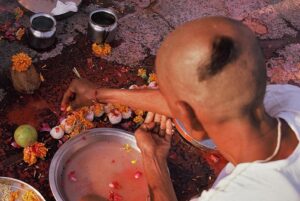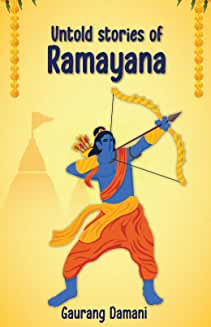 Pitru-s are our departed ancestors, both on the maternal and paternal sides. Vedic scriptures recommend 5 types of shraadha:
Pitru-s are our departed ancestors, both on the maternal and paternal sides. Vedic scriptures recommend 5 types of shraadha:
- Nitya shraadha wherein we symbolically offer food every day to our pitru-s before having our meal
- Naimittika shraadha is performed on occasions like a death anniversary
- Kaamya shraadha is performed to attain a material desire through their blessings
- Vriddhi shraadha is performed after something beneficial has happened in the family, as a token of gratitude
- Paarvana shraadha is performed during the pitru paksha
Hindus have been performing shraadha rituals since time immemorial. The rituals include daana (charity) and the pinda daana offerings to keep our pitru-s free from hunger and thirst. Our offerings do reach our pitru-s like a calf finds her mother amidst many other cows. When we make an electronic money transfer, doesn’t the amount get deposited in a faraway bank account without any physical contact? There are many examples of shraadha in the epic Ramayana.
Dasharatha of the Suryavanshi dynasty was the king of Ayodhya. He did not have a son who could take charge of his vast kingdom. Rishi Vasishtha advised Dasharatha to perform the Mahalaya shraadha to please his pitru-s. These pinda daana rituals for the departed souls are performed during the pitru paksha period. Vasishtha then recommended to him to worship Goddess Kamakshi in Kanchi. With the blessing of Goddess Kamakshi and his pitru-s, Dasharatha became a father of 4 sons. Rama was his eldest son, followed by Bharata, Lakshmana, and Shatrughna. Rama was married to Mithila’s princess Seeta.
Later due to Kaikeyi’s wish, Rama was sent to a forest for 14 years. Seeta and Lakshmana accompanied him. Soon after, Dasharatha passed away. Vasishtha sent messengers to recall Bharat from Kaikeya, the home of his maternal uncle.
Back in Ayodhya, Bharata performed the funeral rites of his father. After completing the shraadha rituals, on the 14th day, the ministers proposed to Bharata to become the king of Kosala. Bharat not only refused to become the king but also decided to convince Rama to return to Ayodhya to rule.
Bharata met Rama in Chitrakoota. Rama was heartbroken to hear about their father’s death. On the banks of River Mandakini, Seeta, Rama, and Lakshmana performed pinda daana. After the rituals, Rama convinced Bharata to return and govern the kingdom.
Rama, Seeta, and Lakshmana travelled extensively in the Dandaka Forest and settled down in Panchavati. They performed rituals to satisfy their ancestors at pitru teertha on the auspicious banks of River Godavari. One may wonder, do our offerings reach the departed souls? This is answered by an event described in Garuda Purana.
Rama, Seeta, and Lakshmana visited Pushkara in present-day Rajasthan state. They performed shraadha rituals for the departed ancestors in this holy town. Seeta and Rama served food to the invited ascetics with great diligence. Suddenly, she ran away and hid behind some trees. After Rama completed feeding the sages, he asked Seeta why she did so. She replied that she saw her father-in-law and his father and grandfather descending from the other world to accept the pinda daana offerings. Since they wore royal attires, she felt embarrassed in her soiled bark clothes and moved away. Rama expressed amazement at the miracle that she saw 3 generations of pitru-s.
Later, back in Panchavati, Ravana kidnapped Seeta with deceit. He flew her to Lanka and held her captive there. Rama and Lakshmana walked hundreds of yojana-s in search of her. They encountered and overcame the ferocious Rakshasa-s Ayomukhi and Kavandha. Then, they took the help of Hanuman who traced her in Lanka. Sugreeva’s vanara sena built Rama Setu, the incredible bridge over the southern seas.
When Ravana refused to return Seeta to Rama, there was no other option but to fight a war. Since it was the first day of the shraadha period during Dakshinayana, Rama worshipped his pitru-s. He performed the paarvana shraadha rituals on poornima (full moon day). Then, with the sounds of conches and drums and shouts of ‘Jai Shree Rama’, the fierce war began against Ravana and his Rakshasa army.
Rama’s vanara sena killed many Rakshasa-s. Rama slayed the ferocious Kumbhakarna. Lakshmana killed Indrajit on the day before amavasya (no-moon). A furious Ravana re-entered the battlefield on amavasya, the last day of the shraadha period. Rama had found time since the start of the war to worship his ancestors for the entire 16-day pitru paksha.
With the blessings of his pitru-s and Goddess Durga, Rama killed Ravana on the 9th day after pitru paksha. Vibhishana was made the king of Lanka, and they returned to Ayodhya. Rama and Seeta sat on the throne and ruled together.
Before their forest exile, Seeta had taken a vow to worship Rivers Ganga and Yamuna for their safe return. As per Seeta’s wishes, Rama and Seeta undertook an extensive teertha yatra to Prayaga, Kashi, and Gaya.
In Gaya, Rama performed the pancha teertha yatra and offered pinda daana at pretashila. When Dasharatha did not appear to accept it, Seeta disclosed the recent events. Seeta was playing with wet sand on the banks of River Phalgu, which her father-in-law accepted as her pinda daana. Rama expressed surprise that a pitru could accept sand as an offering. To testify her story, Seeta asked the mango tree which stayed silent out of some arbitrary fear of Rama. River Phalgu, the local Brahmana-s, a cat, a cow, and a peepala tree did the same. Finally, she prayed to Surya (the solar demigod) who endorsed Seeta’s story. By this time, Dasharatha also appeared in an aerial craft. He said he did so, as sometimes there are many obstacles in Gaya for a regular pinda daana. He accepted Rama’s pinda and left.
Thus, we can see how Ramayana and other scriptures emphasize the importance of shraadha. Also, it is our Dharma (duty) to please our pitru-s, as we could not have taken birth without them.

This article is an excerpt from the book
‘Untold stories of Ramayana‘ by Gaurang Damani
This article also appeared on the Hindu Post website
